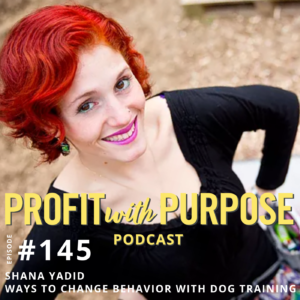Shana Yadid is the Founder, CEO & Lead Trainer at Yadid’it! Dog Training. The most pivotal moment in Shana’s life began shortly after her  21st birthday when she started reading Temple Grandin’s “Animals in Translation, Using the Mysteries of Autism to Decode Animal Behavior.” It was then that her understanding of her relationship with animals began to unfold.
21st birthday when she started reading Temple Grandin’s “Animals in Translation, Using the Mysteries of Autism to Decode Animal Behavior.” It was then that her understanding of her relationship with animals began to unfold.
One of the things that fascinates me about dog training is the use of practical psychology. So if you don’t have a dog, this episode isn’t just about dogs, it’s about behavior training. In many ways, we can be very similar to dogs in the sense where we make associations — especially when a situation was painful and we can reassociate.
In this episode, we talk about neural associations, classical conditioning, redirecting attention and more.
So you grew up in New York? And you didn’t have a dog growing up?
Shana grew up in New York. She didn’t have her own dog, but she had everybody else’s dog. There were over 700 apartments in the building she lived in.
You now have how many dogs?
She has six dogs. They are all rescues.
Did you know that you wanted to be a dog trainer because of your love of dogs?
She came to dog training in her early twenties after being a pet sitter. She read a book by Temple Grandin about using the mysteries of autism to translate animal behavior. Even though Shana isn’t on the spectrum, it taught her a lot about how she thought and how she learned.
There is so much psychology in dog training.
Shana thinks of herself as a novice behavioral scientist. She doesn’t have a degree in it but has read widely on the subject of both humans and dogs. She finds the brain fascinating.
I have a dog, and I love dogs. I have a 4lbs teacup Yorkie. Her name is Brook Lyn. Let’s get into psychology. I find it fascinating how behavior can be facilitated. I know you also have experience with traumatized dogs. How can you tell that a dog has been traumatized?
It’s not just about if a dog has suffered trauma or not. Some dogs just have anxious genetics. When you have a rescue dog that came from a shelter, certain assumptions can be made when you have no information, and you see certain behavior. If a dog runs across the room and hides under a table because you touched a broom that is likely to be a PTSD response. You shouldn’t feel bad about touching the broom. We have to train the dog to reassociate the broom by changing their neural pathways and how they view the broom.
Neural Association. Can you explain what that is and how it works?
With a dog that is afraid of a broomstick, Shana would first lay the bro0m on the floor and take the dog over to it, as close as it will come without panic. Then she will get excited, tell them they did a “good job” and give them a treat. For Shana, when she sees all of the current legislation that is questioning women’s bodily autonomy, that is a trigger for her. That puts her into a headspace, which makes it hard to remember she is worth anything. Then she puts on a song like Brave by Sarah Brellis or another motivational girl power song. She sings it to her inner child. That reawakens her spark. Although it might feel like she doesn’t want to push forward, that’s her brain taking all these traumas and telling her something which is not the truth. If she can figure out what the trigger is she can reassociate it. With the dog, she is trying to teach them that broomstick means treat rather than broomstick means beat.
You literally associate a new meaning with the trigger. From a coaching perspective, we go back to an event and identify the meanings which were created during that time. Then we create a new meaning which is essentially a new association.
Let’s get into some practical dog stuff. Stating simply, how would you get a dog to sit?
You move your hand in a certain direction so that the dog ends up in the position you want. For a sit, she would bring her hand over the dog’s head until their butt hit the ground. Sometimes you have to change certain things to set them up for their best success, so you can give them the reward. Once they have earned the reward they are much more likely to repeat the behavior. You start with food law. Then that turns into a hand signal which gets overlaid with a verbal command. That’s how a dog learns verbal clues. Shana thinks that non-verbal commands are often more effective and more helpful. One of the first things she teaches is a focus command – Watch me – and requires eye contact.
How do you get a dog to stop barking at the door?
There are a few different ways. With terriers, they are often just alerting. Shana has taught one of her dogs ‘thank you, that’s enough’.
How did you train that?
They start barking. You acknowledge what it is they’re barking at. Say they are barking at the window. You go over to the window and lookout. You’re giving them the impression that you recognize what they are alerting you to. Then you give them a thank you and something else to do. Shana will give her dog a treat and then put him on the couch or take him with her to another room.
So classical conditioning.
Classical conditioning is the use of positive and negative reinforcement and positive and negative punishment. All 4 facets come into play when you are training a dog. In positive based training, you give them a treat whenever they get it right. Every other time they still get the treat and you rest after.
What do you mean by positive punishment?
Negative punishment is the removal of something such as a treat and positive punishment is giving something such as a leash correction. Positive reinforcement is you get the treat. Negative reinforcement is you get a correction. For Shana balanced training is about explaining to a dog why they are wrong with a verbal or physical cue. They try again and if they get it right they get a treat. It’s clear balanced communication of both yes and no.
Do you think dogs can read energy?
Absolutely. Her dog Amber went with her to her level 1 Reiki attunement and now does reiki on people all the time. Shana catches her doing it and thinks it’s adorably hilarious.
What’s the best advice you’ve ever been given?
You don’t have to be the richest, smartest or prettiest person in the room. But if you want to succeed in business the one thing you should always be is the most adaptable person in the room. That is the key to success.
Tell us how we can get in touch with you?
Instagram: https://www.instagram.com/shanayadid
Facebook: https://www.facebook.com/shananigan.yadid
Sustainable Dog Rescue: https://www.sustainablerescue.org/
Yadid’t Dog Training: https://www.yadiditdog.training


Search
Popular Posts
- 02 Mar 2008The Flowering of Human Consciousness 7 Comments
- 01 May 2014Using Visualization to Create What You Want 7 Comments
- 14 Mar 2014I walked on Fire! 4 Comments
- 26 Mar 20133 Questions to Change Your Career 4 Comments
- 29 May 2014How to Bust Through Your Fear 4 Comments
